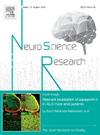Dopamine dynamics underlying maternal motivation and reward
IF 2.4
4区 医学
Q3 NEUROSCIENCES
引用次数: 0
Abstract
Maternal behavior comprises a diverse set of caregiving actions essential for ensuring offspring survival and development. Shaped by evolutionary pressures, these behaviors range from goal-directed and coordinated overt motor actions such as nest building and pup retrieval to sustained akinetic states such as nursing and crouching. These can each be thought of as varying along two continua, one which captures the appetitive versus consummatory aspects of a given behavior, and the other describes the relative activity or passivity of the behavior. Since individual behaviors (1) vary substantially along these axes, and (2) evolve in time, we propose that motivated execution of them is likely accomplished through dynamic regulation by multiple circuits and neuromodulatory systems. One important regulator of maternal behaviors is dopamine (DA), a key neuromodulator that makes diverse contributions to behavior. Classically, dopamine is hypothesized to play a role in both the appetitive (e.g. pup retrieval) and consummatory (e.g. nursing, grooming) aspects of maternal behavior via distinct circuitry. Considering recent studies revealing the temporal dynamics of DA during maternal behavior, we examine the complexity of the concepts of appetitive and consummatory drive as maternal behavior unfolds in time. We propose that seemingly discrete behaviors, like pup retrieval, may be appreciated as evolving sequences of appetitive and consummatory components that reflect shifts in underlying neural dynamics at different timescales.
母性动机和奖励背后的多巴胺动态。
母性行为包括确保后代生存和发育所必需的各种照料行为。受进化压力的影响,这些行为范围从目标导向和协调的明显运动行为,如筑巢和幼崽的取回,到持续的动态状态,如护理和蹲伏。这些都可以被认为是沿着两个连续体变化的,一个捕获了给定行为的食欲和圆满的方面,另一个描述了行为的相对主动性或被动性。由于个体行为(1)沿着这些轴变化很大,(2)随时间而变化,我们认为动机的执行可能是通过多回路和神经调节系统的动态调节来完成的。多巴胺(DA)是母亲行为的一个重要调节因子,它是一种关键的神经调节剂,对行为有多种贡献。传统上,多巴胺被假设通过不同的电路在母性行为的食欲(如幼犬检索)和圆满(如护理,梳理)方面发挥作用。考虑到最近的研究揭示了DA在母亲行为中的时间动态,我们研究了随着母亲行为的时间展开,欲望驱动和圆满驱动概念的复杂性。我们提出,看似离散的行为,如幼犬取回,可能被理解为食欲和完善成分的进化序列,反映了不同时间尺度下潜在神经动力学的变化。
本文章由计算机程序翻译,如有差异,请以英文原文为准。
求助全文
约1分钟内获得全文
求助全文
来源期刊

Neuroscience Research
医学-神经科学
CiteScore
5.60
自引率
3.40%
发文量
136
审稿时长
28 days
期刊介绍:
The international journal publishing original full-length research articles, short communications, technical notes, and reviews on all aspects of neuroscience
Neuroscience Research is an international journal for high quality articles in all branches of neuroscience, from the molecular to the behavioral levels. The journal is published in collaboration with the Japan Neuroscience Society and is open to all contributors in the world.
 求助内容:
求助内容: 应助结果提醒方式:
应助结果提醒方式:


